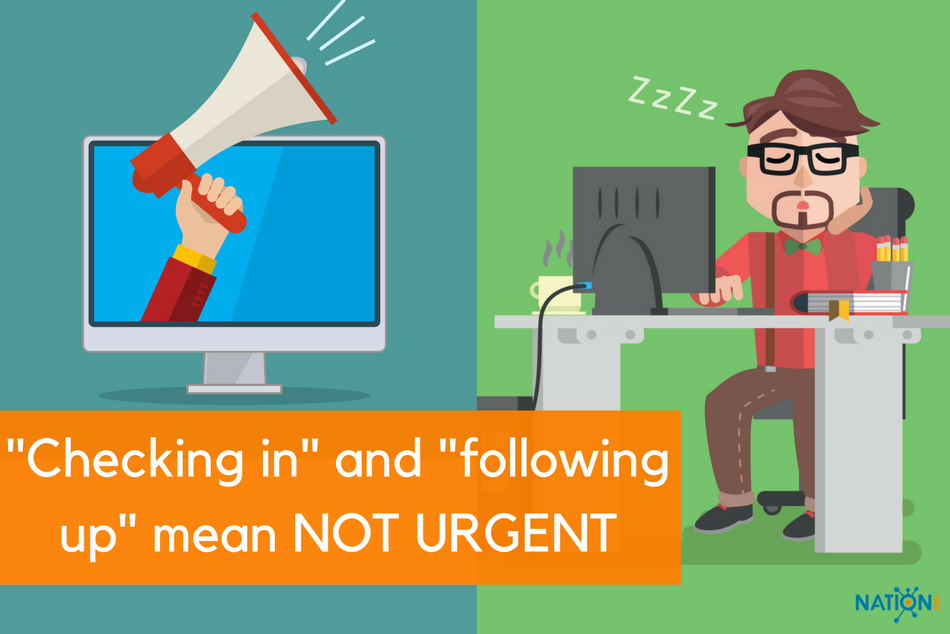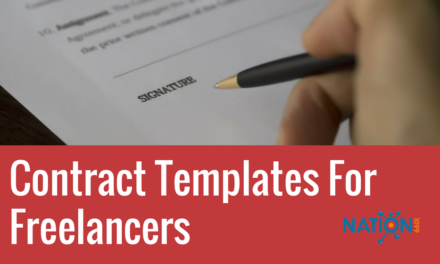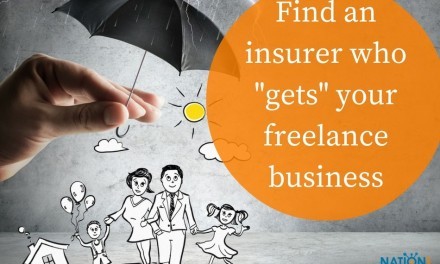Ahhh the famed “keep in touch email” . . . or perhaps you call it the “just checking in –” Many freelancers preach the importance of keeping contacts warm and following up with the elusive “almost-clients.” It’s a simple idea in principle, but when it comes time to actually draft that simple, stupid, no-problem email . . . it turns out, it’s often kind of difficult.
Many of us have a hard time selling ourselves to new clients. But to come back to a contact who didn’t give you the time of day and then, let’s say, took a nice “hiatus” from communicating with you — it can be a real hang-up.
While there are no second chances to make a first impression, an artfully crafted “keep in touch email” can afford you another opportunity to present yourself in a positive light to potential clients, put yourself out there for future projects, and maybe even seal the deal.
But you’ve gotta’ write the darn thing first. Here’s how you break the paralysis and get these done.
Are you looking for ideas on how to grow your freelance career? We put together the best ideas from across Nation1099 into an ebook — 15 Easy Hacks For Finding More Freelance Clients. Even better, this ebook includes two fantastic giveaways to valuable services.
Work with a message, not a template
Google searchers love email templates for some reason. We think, “if I can find just the right template, no one will notice I’m completely phoning it in to every person I’m contacting.” It’s a nice theory, but it rarely works out that way.
Even with the right names and adjectives plugged into the right blanks, most prospects can smell an email template from a mile away. It’s like sending your almost-client a gift basket full of canned fruit around holiday time (if anyone tries this, let me know how it works out). You’re sending out something you know you wouldn’t want, yourself, so why would you expect that a prospect would feel differently?
What is your message to the client (other than “hire me, pleeeeaase”)? Why should they pick up their head and pay attention to you? You don’t necessarily need to reinvent the wheel with every potential client follow-up you send — but you need a driving message to guide you.
If you insist on templates, I’ll give you one, but as you’ll see, it’s a little different from most — it’s more like a strategic outline:
i) You’re doing something new or have something new to show your prospect.
ii) You let the prospect know about it.
iii) You explain how this new thing or information can help their business in a way that’s totally specific to them, what they’re doing or problems they’ve told you they’re having.
iv) You let them have the information/advice/e-book/whitepaper like it’s no big deal.
This outreach method ensures that there is something for the prospect to take notice of and a timely reason to reopen contact with you.
If you put the time in to do it properly, “impressed” will be an understatement (remember, quality absolutely over quantity).
This time . . . it’s personal
Corporations are NOT people — but people definitely are and they really appreciate being treated that way. One of the most informative pieces I’ve read on email marketing so far this year is Tim Soulo’s scathing and hilarious post, I Just Deleted Your Outreach Email Without Reading (And NO, I Don’t Feel Sorry).
Tim’s example emails — sent from a real-life email marketing slacker — illustrate the reasons why so many follow-up emails go right in the trash. It also shows the hilarity that ensues when a sender lazily will not take “no” for an answer.
If you read back your message and it feels like it could be sent to many other contacts without much changing, the email will not work. If it visually looks like a general, fill-in-the-blank announcement, it will not work. The problem you had in your first wave of outreach was that you failed to distinguish yourself to this potential client. Dive into their world and talk to them as an individual.
Pop Quiz: Does your “keep in touch email” have the phrases “checking in,” “just checking in,” following up,” or “just following up again” in the first couple lines? If so — highlight and press delete. In addition to setting a spammy, impersonal tone right from the get-go, you are letting the reader know before they even have to open the email that your message rates a -2 on the urgency scale.
I bet you think this “keep in touch email” is about you . . .
You’ll see this point made in many, many ways, but the short of it is this: if you’re going to send an unsolicited email to a prospect, you’d better make sure that the focus is mostly on them.
As Curtis McHale rightly explained in his splendid guide to saying no, and getting more consulting work, defaulting to the “I am awesome speech” is rarely an effective strategy. Past a certain starting point, prospects do not want to hear about you — they want to see you engage with their problems and propose unique solutions to them.
AfterOffers.com founder Tim Bourquin explores the data behind this logic in his informative blog, Analyzing the Challenges of Email Marketing in 2016. The data, which was obtained from a recent SmartInsights infographic, shows the difference consumer-focused messaging can make relative to company-focused language.
For instance, when it came to offering customers a discount on services, between 37% and 43% of customers felt that consumer-focused, “you” messaging was most effective. Only 14% of marketers felt that brand-centric “we” messaging yielded the best results.
Hint: If you notice yourself using a lot of “I” or “we” in your email, and very little “you,” change that!
Check your sales lingo at the door
What is the email marketing equivalent of “show; don’t tell“? Here it is — “educate; don’t sell.”
Sales stuff is stressful, and it’s usually stressful for both parties involved. In the email marketing world sometimes going right for the sale makes sense — but this is not one of those occasions.
There’s a big difference between being persistent and not learning from experience. Your initial sales pitch may have done nothing wrong, but it didn’t do much to stir your potential clients to action. You’d be wise to step back and approach things a little differently this time.
You obviously want prospects to hire you, but all the high-pressure sales lingo in the Milky Way Galaxy won’t help you if they don’t yet understand how you can help them. Perhaps there’s an information gap that’s keeping them from pulling the trigger. So let’s get specific!
I’ll provide a sample scenario below that, again, is not intended as a strict email template to follow, but rather an example to get you thinking:
Hello Clienty Clientson,
Last time we chatted I remember that you voiced some frustration about your website’s underperformance in lead generation. I’ve noticed that many of my service clients have had similar difficulties in the past, especially with the layout and styling of their landing pages. I put together this quick guide that I think could be very helpful to you and make a big difference in your website’s performance going forward.
Please let me know if you have any questions or would like to talk more about some of the points I raised in the guide.
“Hyperlinked Guide Title”
All the best!
Freelance Freeman
Will your prospect drop everything they’re doing and go fix their website themselves in the way you recommended? It’s possible, but pretty unlikely. They’re busy and they need help. You’ve demonstrated that you already have the solution. They might as well just have you do the work . . .
Even if this approach doesn’t initially result in a new gig, you’ve started a dialogue and, at the very least, you’ve impressed the crap out of your prospect. This is a good position to find yourself in.
Do something kind of crazy
This one isn’t really an email tactic as much as it is a fascinating alternative all-together. In the world of inbox-overload, sometimes one of the most effective ways you can reopen contact with a prospect who’s fallen off is by doing something a little more, shall we say — “old-fashioned.”
Some of you might be familiar with Jake Jorgovan — he’s a talented web designer, entrepreneur and blogger (you’ll see we’ve cited him for some other things here and there on the Nation1099 blog). Last year I came across a very interesting video in which he makes the “elevator pitch” for his company Outbound Creative — an agency that specializes in high-level “just-checking-in” services — and they do so in a very unorthodox way.
In this short video he outlines many of the familiar reasons why so many sales efforts miss the mark and explains how he handles them differently — he sends his clients’ prospects quirky personalized physical packages and kind of breaks their brains in the process. And the funny thing is, most of the time it works.
If you’re hitting a wall with your email outreach, back up for moment and see if you can think of anything creative you could actually send your potential clients (in the real, physical world). There’s a good chance none of your competitors are.
Value first
And once again, we come right back to the topic of value. Credentials and a good track record are nice — so is a very elegant brand ethos — but these are not typically the things that make timid prospects take action. Your value and the totally specific value you offer them are your keys to the kingdom.
In whatever way you approach your “keep in touch email” or “almost-client” outreach, keep the spotlight on them and let them see for themselves that you are the obvious choice.

Ben Shanbrom is a freelance writer, musician and copy editor who works with artists and other clients around his native New Haven and well beyond.












Great post! We will be linking to this great article on our site. Keep up the good writing.
Just want to state that the content of this article is quite good and brings clarity on this subject.